Welcome to my guide on ‘sauce on the side’ nutrition! Whether you’re dining out or cooking at home, understanding the health values and benefits of sauces is crucial for making informed choices. We all love a flavorful sauce to enhance our meals, but it’s important to consider the nutritional impact they can have on our overall diet. In this article, we will delve into the world of ‘sauce on the side’ nutrition and provide you with a comprehensive guide on making healthier choices when it comes to sauces.
- Understanding the nutritional value and impact of sauces on your diet is important for making informed choices.
- Choosing healthier sauce options can help you reduce calorie intake and increase nutritional value.
- Reading sauce nutrition facts and labels can provide valuable information about their calorie, fat, sugar, and sodium content.
- Practical strategies, such as opting for homemade sauces and exploring low-calorie alternatives, can help you make healthier sauce choices.
- Nutritious sauces, such as salsa and guacamole, can enhance the flavor of your meals while providing health benefits.
The Importance of Choosing Healthier Sauces
When it comes to sauces, the choices you make can greatly impact the overall healthiness of your meal. Let’s dive into why choosing healthier sauces is crucial for a balanced diet.
Sauces are often packed with added sugars, unhealthy fats, and excessive sodium, which can contribute to weight gain, high blood pressure, and other health issues. By opting for healthier sauce options, you can reduce your intake of these harmful ingredients while still enjoying the flavors you love.
One way to make healthier sauce choices is by selecting low-calorie alternatives. These sauces are typically made with ingredients like fresh herbs, spices, and natural sweeteners, which add flavor without adding excess calories. For example, homemade salsas and vinaigrettes can be great alternatives to creamy dressings and high-calorie sauces.
Another important factor to consider is the nutritional value of the sauces you choose. Look for sauces that are rich in vitamins, minerals, and antioxidants. For instance, opting for tomato-based sauces can provide you with lycopene, a powerful antioxidant that may help reduce the risk of certain diseases.
| Sauce | Nutritional Value |
|---|---|
| Sweet Chili Sauce | High in sugar, moderate in calories |
| Guacamole | Rich in healthy fats, vitamins, and minerals |
| Marinara Sauce | Low in calories, high in lycopene |
| Teriyaki Sauce | High in sodium and sugar, moderate in calories |
By considering the nutritional value of the sauces you use, you can transform your meals into healthier, well-rounded options. So, next time you reach for that bottle of sauce, take a moment to read the label and choose wisely. Your taste buds and your body will thank you.
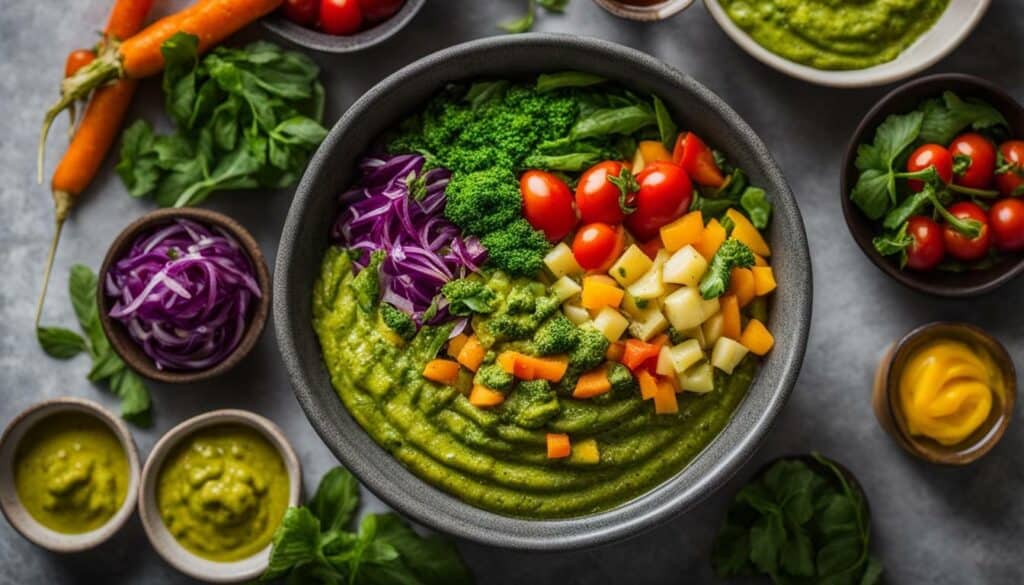
Unpacking Sauce Nutrition Facts
Let’s take a closer look at the nutrition facts of various sauces and condiments, so you can make informed decisions about which ones to include in your meals. Understanding the nutritional profile of different sauces is essential for maintaining a healthy diet and making conscious choices.
When it comes to sauce nutrition, it’s important to pay attention to factors such as calories, fat, sugar, and sodium content. These key components can significantly impact the overall nutritional value of a sauce and its suitability for your dietary needs. Let’s break down the nutrition facts of some common sauces and condiments:
| Sauce | Calories (per serving) | Total Fat (g) | Sugar (g) | Sodium (mg) |
|---|---|---|---|---|
| Ketchup | 20 | 0 | 4 | 160 |
| Mayonnaise | 90 | 10 | 0 | 90 |
| Mustard | 5 | 0 | 0 | 120 |
| Barbecue Sauce | 70 | 0 | 14 | 350 |
These figures are just a snapshot of the nutrition facts, and it’s important to consider portion sizes and personal dietary requirements when making sauce choices. For example, if you’re watching your sodium intake or trying to reduce added sugars, you may opt for sauces with lower values in those categories.
Choosing Condiments Wisely
When it comes to condiments, it’s worth noting that some options are naturally lower in calories and fat. For instance, salsa and hot sauces tend to be lower in calories and fat compared to creamy dressings or mayonnaise-based sauces. Choosing these options can be a flavorful way to enhance your meals while keeping your calorie intake in check.
Remember, moderation is key when incorporating sauces and condiments into your diet. While they can add taste and excitement to your dishes, it’s crucial to be mindful of portion sizes and overall nutritional balance.
By being aware of the sauce nutrition facts and making smarter choices, you can enjoy the flavors you love while maintaining a healthy eating plan. So, next time you reach for a sauce, take a moment to consider its nutrition profile and how it fits into your overall diet.

Strategies for Making Healthier Sauce Choices
Making healthier sauce choices doesn’t have to be complicated. Here are some strategies you can use to ensure you’re picking sauces that align with your nutritional goals:
- Read Labels Carefully: Take the time to read the nutrition labels of sauces and condiments before making a purchase. Look for options that are low in calories, saturated fat, sugar, and sodium. Opt for sauces that are made with natural ingredients and avoid those that contain artificial additives or preservatives.
- Opt for Homemade Sauces: Making your own sauces at home allows you to have complete control over the ingredients. You can choose to use healthier alternatives such as Greek yogurt, herbs, and spices, instead of high-calorie and high-fat ingredients. Experiment with different flavors and ingredients to create unique and nutritious sauces.
- Explore Low-Calorie Alternatives: There are many low-calorie alternatives available in the market that can help you cut down on excess calories without compromising on taste. Look for options such as light mayonnaise, low-sodium soy sauce, and reduced-fat salad dressings. These alternatives can provide similar flavors while being lower in calories and unhealthy fats.
- Use Sauces Sparingly: Portion control is key when it comes to sauces. Instead of drowning your meals in sauce, use them sparingly to add flavor without adding excessive calories or sodium. Consider using a small amount and spreading it evenly to cover your food, rather than pouring it all in one place. This way, you can still enjoy the taste while keeping the nutritional impact in check.
By incorporating these strategies into your sauce choices, you can make healthier decisions that support your overall well-being. Remember, small changes can make a big difference when it comes to improving your diet and leading a healthier lifestyle.
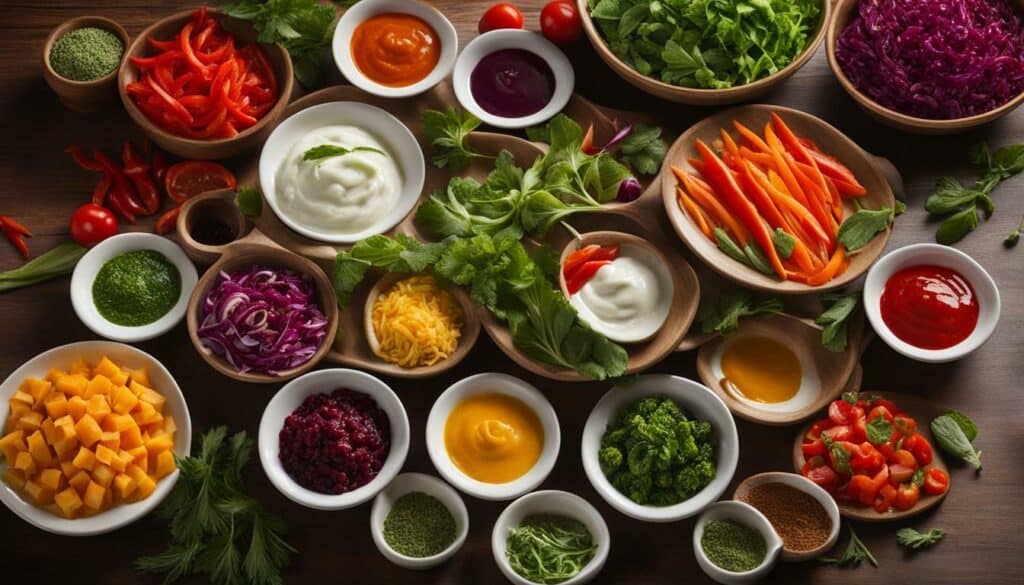
Enhancing Flavor with Nutritious Sauces
It’s time to get creative in the kitchen! Discover how you can enhance the flavor of your meals while boosting their nutritional value with these nutritious sauce options. Whether you’re looking to add a punch of flavor to your favorite dishes or amp up the health benefits of your meal, these sauces will do the trick. Let’s dive in!
One delicious and nutrient-rich sauce option is salsa. Made from fresh tomatoes, onions, peppers, and herbs, salsa is not only bursting with flavor but also packed with vitamins and minerals. Plus, it’s low in calories and fat, making it a guilt-free addition to your meals. Try it as a topping for grilled chicken, fish, or even as a dip for your favorite veggies.
Add a creamy and healthy twist to your meals with guacamole. Made from ripe avocados, lime juice, and spices, guacamole offers a rich and flavorful taste while delivering a dose of heart-healthy fats and fiber. Use it as a spread on sandwiches, a topping for tacos, or as a dip for tortilla chips. You can also try different variations by adding ingredients like diced tomatoes, onions, or cilantro for an extra burst of freshness.
For those who enjoy a little kick in their meals, hot sauce is a fantastic choice. Made from chili peppers, vinegar, and spices, hot sauce not only adds heat but also boosts metabolism and aids digestion. It’s a perfect complement to eggs, grilled meats, or even drizzled over roasted vegetables. Just be sure to read the label and choose a hot sauce without added sugars or excessive sodium.
| Sauce | Nutritional Value |
|---|---|
| Salsa | Low in calories and fat, packed with vitamins and minerals |
| Guacamole | Heart-healthy fats and fiber |
| Hot Sauce | Metabolism-boosting and aids digestion |
Try these mouthwatering sauce options today!
Incorporating these nutritious sauces into your meals is not only a way to enhance flavor but also a way to add valuable nutrients. Experiment with different combinations and get creative with your recipes. Your taste buds and your body will thank you!

Don’t worry about missing out on your favorite sauces – I’ve got you covered with these healthy substitutions that will keep both your taste buds and your health happy. When it comes to choosing healthier sauce options, there are plenty of alternatives to explore that are lower in calories and offer more nutritional value. Whether you’re looking to reduce fat, cut back on sugar, or decrease sodium intake, these substitutions will help you make healthier choices without compromising on flavor.
One of the simplest ways to create healthier sauces is by using Greek yogurt as a base. It’s creamy, tangy, and packed with protein, making it a nutritious alternative to mayonnaise, cream, or sour cream. Add some fresh herbs and a squeeze of lemon juice to create a flavorful dressing or dip. You can also experiment with using avocado as a healthy fat substitute. Mash up ripe avocado with some lime juice and spices to make a delicious guacamole or creamy sauce for tacos and salads.
If you’re a fan of tomato-based sauces, try making your own marinara sauce using fresh tomatoes, garlic, and herbs. This homemade version allows you to control the amount of added sugar and salt, making it a healthier alternative to store-bought options. Another low-calorie and nutritious sauce option is salsa. Whether it’s chunky or smooth, salsa adds a burst of flavor to any dish and can be used as a topping, dip, or marinade. Opt for homemade salsa to avoid unnecessary preservatives and additives.
To help you choose healthier sauces, I’ve created a table below that compares the nutritional value of common condiments and their healthier substitutes. This way, you can make informed choices and enjoy your meals guilt-free! Remember, small changes can make a big difference in your overall diet and well-being.
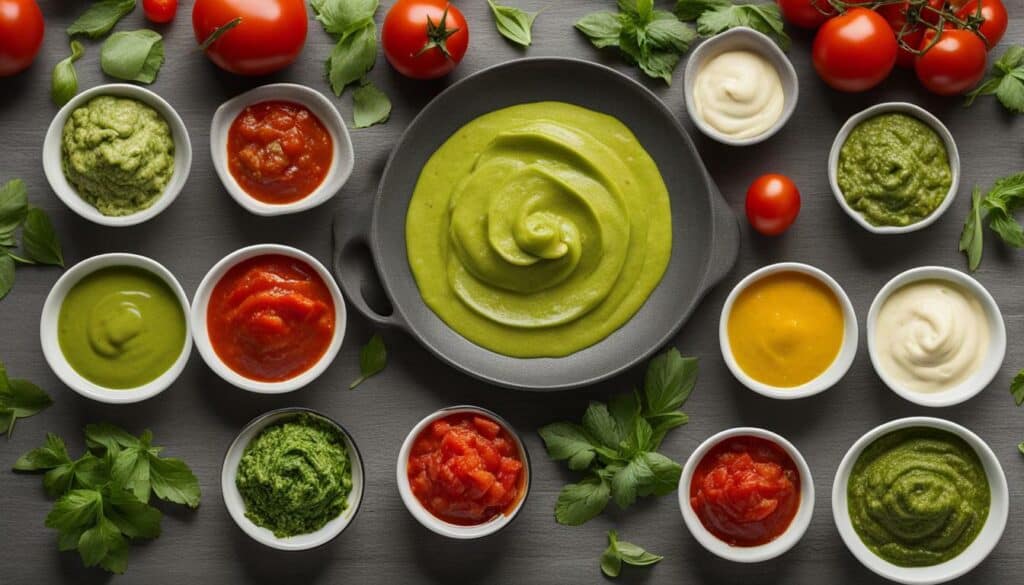
Get ready to take a culinary trip around the world as we uncover nutritious sauce choices for different cuisines. From Italian to Asian to Mediterranean flavors, we’ve got you covered with delicious and healthy options to enhance your meals.
Italian Cuisine
Italian cuisine is known for its rich and flavorful sauces. Instead of heavy cream-based sauces, opt for lighter options like marinara sauce or pesto. Made with fresh tomatoes and herbs, marinara sauce is low in calories and provides a good dose of vitamins and minerals. Pesto, made with basil, pine nuts, and olive oil, adds a burst of flavor and healthy fats to your pasta dishes.
| Sauce | Calories | Fat | Sugar | Sodium |
|---|---|---|---|---|
| Marinara Sauce | 45 | 1g | 5g | 370mg |
| Pesto Sauce | 80 | 8g | 0g | 190mg |
Asian Cuisine
Asian cuisine offers a variety of nutritious sauce options. Soy sauce, although high in sodium, adds flavor to stir-fries and sushi. Opt for reduced-sodium soy sauce or tamari for a healthier alternative. Other healthy Asian sauces include ginger, garlic, and chili-based sauces. These sauces are low in calories and pack a punch of flavor.
| Sauce | Calories | Fat | Sugar | Sodium |
|---|---|---|---|---|
| Soy Sauce | 10 | 0g | 1g | 920mg |
| Ginger Sauce | 30 | 0g | 7g | 110mg |
Mediterranean Cuisine
Mediterranean cuisine is known for its use of fresh herbs, olive oil, and lemon juice. Tzatziki sauce, made with Greek yogurt, cucumber, and dill, is a healthy and refreshing option that pairs well with grilled meats and veggies. Hummus, made from chickpeas, tahini, and olive oil, is a protein-rich sauce that can be used as a dip or spread.
| Sauce | Calories | Fat | Sugar | Sodium |
|---|---|---|---|---|
| Tzatziki Sauce | 35 | 3g | 2g | 65mg |
| Hummus | 70 | 5g | 0g | 125mg |
Next time you’re cooking up a storm or dining out, consider incorporating these nutritious sauce choices into your meals. They not only add flavor but also provide health benefits. Remember, making informed sauce choices is a delicious way to maintain a healthy lifestyle!
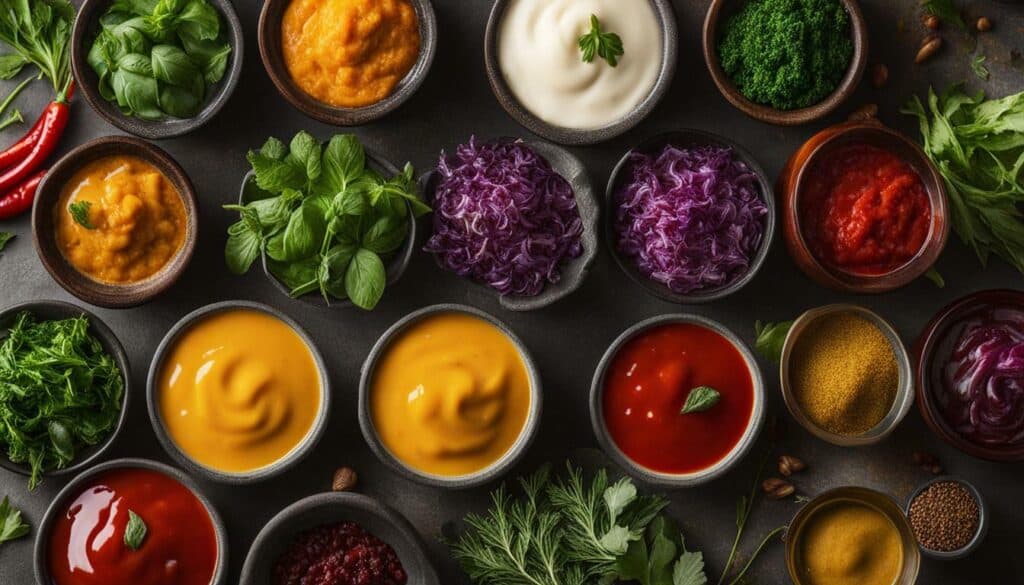
Incorporating Sauce Nutrition into Your Diet
Now that you have a better understanding of sauce nutrition, let’s explore how you can incorporate it into your diet for a well-rounded and healthy eating plan. Making informed choices about the sauces you use can have a significant impact on the overall nutritional value of your meals.
One strategy for incorporating sauce nutrition into your diet is to prioritize homemade sauces. By making your own sauces, you have control over the ingredients and can ensure they are made with wholesome, nutritious options. For example, you can create a simple tomato sauce using fresh tomatoes, garlic, and herbs, rather than relying on store-bought options that may contain added sugars or unhealthy additives.
Another important consideration is portion control. While sauces can add flavor and enjoyment to a meal, it’s essential to be mindful of the quantities you use. Too much sauce, even if it’s healthy, can lead to an imbalance in your overall meal. One way to practice portion control is by using a table spoon or small ladle to measure out the desired amount of sauce, rather than pouring or smothering it over your food.
Additionally, exploring low-calorie and nutritious sauce alternatives can be a game-changer for your diet. Many traditional high-calorie sauces can be substituted with healthier options without sacrificing taste. For example, instead of using a creamy dressing on your salad, try a homemade vinaigrette with olive oil, vinegar, and herbs. This swap reduces the calorie content while still providing a burst of flavor.
| Sauce | Calories per Serving | Fat per Serving | Sugar per Serving | Sodium per Serving |
|---|---|---|---|---|
| Tomato Sauce | 40 | 1g | 5g | 300mg |
| Mayonnaise | 90 | 10g | 0g | 80mg |
| Pesto | 120 | 12g | 5g | 200mg |
| Soy Sauce | 10 | 0g | 0g | 1000mg |
Remember, incorporating sauce nutrition into your diet is all about making conscious choices that align with your health goals. By opting for homemade sauces, practicing portion control, and exploring healthier alternatives, you can enjoy the flavors you love while nourishing your body with nutritious options.

Congratulations on completing this journey into the world of ‘sauce on the side’ nutrition! Armed with this knowledge, you can now confidently navigate the sauce aisle and restaurant menus for healthier choices.
When it comes to choosing healthier sauces, it is important to understand the impact they can have on your overall diet. By opting for low-calorie alternatives and homemade sauces, you can reduce your intake of excess calories, fat, sugar, and sodium.
Remember to read labels carefully and pay attention to portion sizes. By incorporating nutritious sauces like salsa, guacamole, and other homemade options, you can enhance the flavor of your meals while also reaping the health benefits they provide.
Whether you’re a fan of Italian, Asian, or Mediterranean cuisines, there are nutritious sauce options available for every palate. And when dining out, don’t be afraid to ask about the preparation of the food and make healthy swaps when ordering.
Building a balanced meal, understanding menu options in terms of calories and salt, and controlling portion sizes are all key factors in making healthier sauce choices. So go ahead, enjoy your meals, and make informed decisions to support a healthier lifestyle.
FAQ
Q: How can I make healthier choices when it comes to sauces?
A: Making healthier choices when it comes to sauces can be achieved by opting for homemade sauces, reading labels carefully, and exploring low-calorie alternatives.
Q: What are some low-calorie sauce alternatives?
A: Some low-calorie sauce alternatives include salsa, guacamole, and other homemade sauces that not only add taste but also provide health benefits.
Q: How can I incorporate sauce nutrition into my diet?
A: You can incorporate sauce nutrition into your diet by practicing portion control, planning balanced meals, and utilizing nutrition information to make the best choices.
Q: Are there healthier sauce options for different cuisines?
A: Yes, there are healthier sauce options for various cuisines. Whether you’re a fan of Italian, Asian, or Mediterranean flavors, we can suggest sauces that are both delicious and healthy.
Q: Why is it important to choose healthier sauce options?
A: Choosing healthier sauce options is important because high-calorie sauces can impact your overall diet. By opting for lower calorie alternatives, you can make healthier choices and maintain a balanced diet.
Q: What are some strategies for making healthier sauce choices?
A: Some strategies for making healthier sauce choices include opting for homemade sauces, reading labels carefully, and exploring low-calorie alternatives.
Q: What are the nutritional facts of common sauces and condiments?
A: We will discuss the nutrition facts of common sauces and condiments, breaking down their calorie, fat, sugar, and sodium content, to provide you with a better understanding of their nutritional profile.
Q: How can I enhance the flavor of my meals with nutritious sauces?
A: You can enhance the flavor of your meals with nutritious sauces by using options like salsa, guacamole, and other homemade sauces that not only add taste but also provide health benefits.
Q: What are some healthy sauce substitutions I can make in my favorite recipes?
A: There are healthy sauce substitutions you can make in your favorite recipes. We will provide alternatives for high-calorie and high-fat sauces, allowing you to enjoy your meals without sacrificing taste or nutrition.
Q: How can I check the nutrition information of sauces in advance?
A: You can check the nutrition information of sauces in advance by visiting the restaurant’s website or contacting them directly. This will help you make informed choices and plan your meals accordingly.
What are the Nutritional Benefits of Italian Dressing Compared to Other Sauces?
Italian dressing offers several nutritional benefits compared to other sauces. The secrets of italian dressing nutrition lie in its use of healthy ingredients like olive oil, herbs, and vinegar. With lower fat and calorie content, it becomes a healthier choice. Additionally, Italian dressing provides antioxidants, omega-3 fatty acids, and heart-healthy nutrients, boosting overall nutrition.

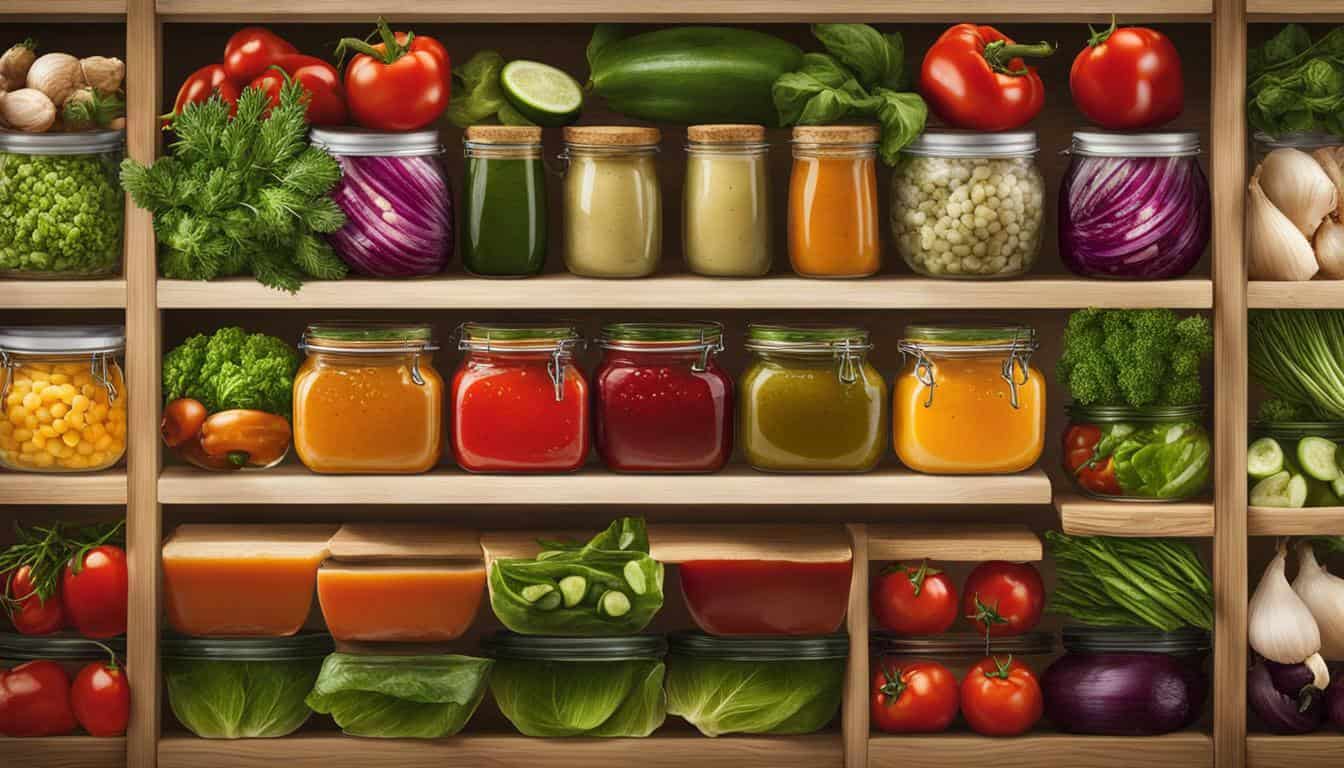



Leave a Reply